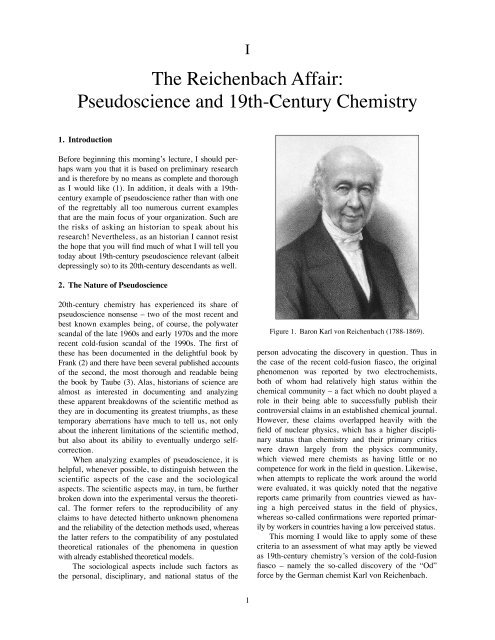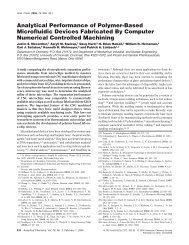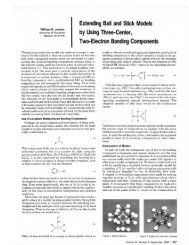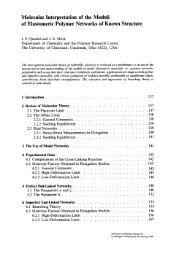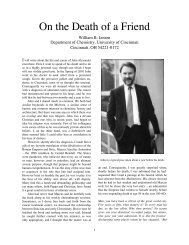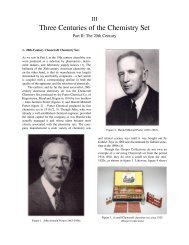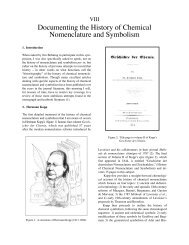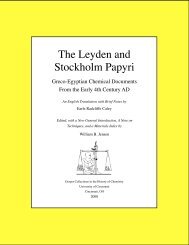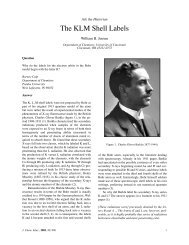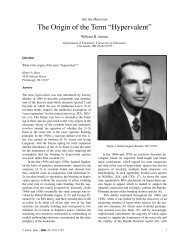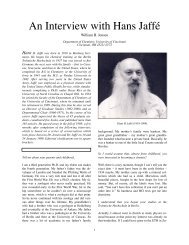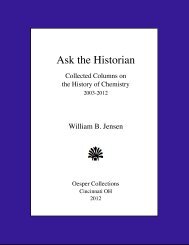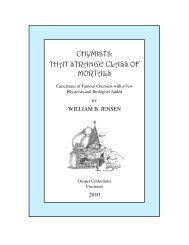Frankenstein's Cat.pdf - University of Cincinnati
Frankenstein's Cat.pdf - University of Cincinnati
Frankenstein's Cat.pdf - University of Cincinnati
Create successful ePaper yourself
Turn your PDF publications into a flip-book with our unique Google optimized e-Paper software.
I<br />
The Reichenbach Affair:<br />
Pseudoscience and 19th-Century Chemistry<br />
1. Introduction<br />
Before beginning this morning’s lecture, I should perhaps<br />
warn you that it is based on preliminary research<br />
and is therefore by no means as complete and thorough<br />
as I would like (1). In addition, it deals with a 19thcentury<br />
example <strong>of</strong> pseudoscience rather than with one<br />
<strong>of</strong> the regrettably all too numerous current examples<br />
that are the main focus <strong>of</strong> your organization. Such are<br />
the risks <strong>of</strong> asking an historian to speak about his<br />
research! Nevertheless, as an historian I cannot resist<br />
the hope that you will find much <strong>of</strong> what I will tell you<br />
today about 19th-century pseudoscience relevant (albeit<br />
depressingly so) to its 20th-century descendants as well.<br />
2. The Nature <strong>of</strong> Pseudoscience<br />
20th-century chemistry has experienced its share <strong>of</strong><br />
pseudoscience nonsense – two <strong>of</strong> the most recent and<br />
best known examples being, <strong>of</strong> course, the polywater<br />
scandal <strong>of</strong> the late 1960s and early 1970s and the more<br />
recent cold-fusion scandal <strong>of</strong> the 1990s. The first <strong>of</strong><br />
these has been documented in the delightful book by<br />
Frank (2) and there have been several published accounts<br />
<strong>of</strong> the second, the most thorough and readable being<br />
the book by Taube (3). Alas, historians <strong>of</strong> science are<br />
almost as interested in documenting and analyzing<br />
these apparent breakdowns <strong>of</strong> the scientific method as<br />
they are in documenting its greatest triumphs, as these<br />
temporary aberrations have much to tell us, not only<br />
about the inherent limitations <strong>of</strong> the scientific method,<br />
but also about its ability to eventually undergo selfcorrection.<br />
! When analyzing examples <strong>of</strong> pseudoscience, it is<br />
helpful, whenever possible, to distinguish between the<br />
scientific aspects <strong>of</strong> the case and the sociological<br />
aspects. The scientific aspects may, in turn, be further<br />
broken down into the experimental versus the theoretical.<br />
The former refers to the reproducibility <strong>of</strong> any<br />
claims to have detected hitherto unknown phenomena<br />
and the reliability <strong>of</strong> the detection methods used, whereas<br />
the latter refers to the compatibility <strong>of</strong> any postulated<br />
theoretical rationales <strong>of</strong> the phenomena in question<br />
with already established theoretical models.<br />
! The sociological aspects include such factors as<br />
the personal, disciplinary, and national status <strong>of</strong> the<br />
Figure 1. Baron Karl von Reichenbach (1788-1869).<br />
person advocating the discovery in question. Thus in<br />
the case <strong>of</strong> the recent cold-fusion fiasco, the original<br />
phenomenon was reported by two electrochemists,<br />
both <strong>of</strong> whom had relatively high status within the<br />
chemical community – a fact which no doubt played a<br />
role in their being able to successfully publish their<br />
controversial claims in an established chemical journal.<br />
However, these claims overlapped heavily with the<br />
field <strong>of</strong> nuclear physics, which has a higher disciplinary<br />
status than chemistry and their primary critics<br />
were drawn largely from the physics community,<br />
which viewed mere chemists as having little or no<br />
competence for work in the field in question. Likewise,<br />
when attempts to replicate the work around the world<br />
were evaluated, it was quickly noted that the negative<br />
reports came primarily from countries viewed as having<br />
a high perceived status in the field <strong>of</strong> physics,<br />
whereas so-called confirmations were reported primarily<br />
by workers in countries having a low perceived status.<br />
! This morning I would like to apply some <strong>of</strong> these<br />
criteria to an assessment <strong>of</strong> what may aptly be viewed<br />
as 19th-century chemistry’s version <strong>of</strong> the cold-fusion<br />
fiasco – namely the so-called discovery <strong>of</strong> the “Od”<br />
force by the German chemist Karl von Reichenbach.<br />
1


